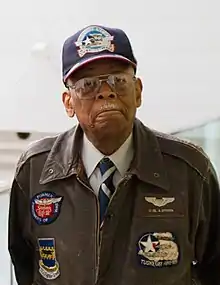Alexander Jefferson
Lt. Col. Alexander Jefferson (born November 15, 1921) is a retired US Air Force officer, famous as one of the Tuskegee Airmen, the 332nd Fighter Group. He served in the U.S. Army Air Corps during World War II.
Alexander Jefferson | |
|---|---|
 | |
| Born | 15 November 1921 Detroit, Michigan, United States |
| Allegiance | United States of America |
| Service/ | United States Army Air Forces United States Air Force |
| Years of service | 1942-1969 |
| Rank | Lieutenant Colonel |
| Unit | 332nd Fighter Group and US Air Force Reserve |
| Battles/wars | World War II |
| Awards | Distinguished Flying Cross Air Medal Purple Heart |
His book, Red Tail Captured, Red Tail Free: Memoirs of a Tuskegee Airman and POW, is a personal memoir of those who served America in World War II and after.
Early life
Jefferson was born in Detroit, Michigan, the eldest child of Alexander Jefferson and Jane White Jefferson. His maternal great-grandfather William Jefferson White was born to a slave woman and a white slave owner in the 1830s. Jefferson's grandfather became a minister, and in 1867, opened an all black ministry school for boys in Augusta, Georgia, which today is known as Morehouse College.[1]
Jefferson attended Craft Elementary School, Munger Intermediate School, and Chadsey High School, graduating in 1938, the only African-American to take college preparatory classes.[1] In 1942, he graduated from Clark College in Atlanta, Georgia, with a Bachelor of Science degree in Chemistry and Biology.
World War II
On September 23, 1942, he was sworn into the United States Army Reserves, volunteering but not accepted for flight training. Taking a job as an analytical chemist for three months, he entered the graduate school of Howard University, applying again to the US Army Air Force.[2]
Called up for flight training in April 1943, Jefferson received orders to report to Tuskegee Army Air Field to begin flight training. Receiving his pilots wings and officer's commission at Tuskegee, he was assigned to the 332nd "Red Tail" Fighter group at the Ramitelli Airfield near Foggia, Italy, flying the P-51 Mustang. Assigned to a fighter escort wing protecting bombing missions of the US 15th Air Force, his job was to attack key ground targets and guard the bombing mission against enemy Nazi Luftwaffe fighters.[2]
During his 19th mission over Toulon, southern France on August 12, 1944, while attacking a radar installation he was shot down.[3] Parachuting to safety and landing within a forest, he was immediately captured by Nazi ground troops. He was sent to prisoner of war camp Stalag Luft III in Poland, a specialist Luftwaffe-run camp for captured Allied Air Force personnel. During his period of internment, Jefferson comments that he was treated like any other Air Force officer by his German captors.[2] He was then moved to Stalag VII-A, just outside Dachau. After the Russian Army entered Poland, the prisoners were marched to Munich by the Germans, where they were freed by General George Patton's US Third Army.[2] Jefferson returned to the United States on board the Cunard liner RMS Queen Mary, arriving in New York city in mid-1945:
Having been treated by the Nazis like every other Allied officer, I walked down the gang plank wearing an Army Air Corps Officer's uniform towards a white US Army sergeant on the dock, who informed us "Whites to the right, niggers to the left."
Postwar career
Jefferson served as an instrument instructor at Tuskegee Army airfield, until it closed in 1946.[2] He remained in the US Air Force reserves, finally retiring in 1969. In 1947 Jefferson received his teaching certificate from Wayne State University, and began teaching elementary school science for the Detroit Public School System.[1] He received his M.A. degree in education in 1954, and was appointed assistant principal in 1969. He retired in 1979 as an assistant principal, after over 30 years service.[3]
Legacy
Honors
In 1995, Jefferson was enshrined in the Michigan Aviation Hall of Fame.[1] In 2004, President George W. Bush awarded Jefferson with a Purple Heart for being wounded while being shot down over German occupied France. On March 29, 2007, Jefferson attended a ceremony in the U.S. Capitol rotunda, where he and all the other members of the Tuskegee Airmen (and their widows) were collectively awarded the Congressional Gold Medal in recognition of their service.[4]
Documentary
A documentary, The Luft Gangster: Memoirs of A Second Class Hero (2016), was made about the life and legacy of Jefferson.[5]
References
- "Lt. Col. Alexander Jefferson". thehistorymakers.com. Retrieved 2010-11-26.
- "Lt. Col. Alexander Jefferson". thechallengercenter.com. Retrieved 2010-11-26.
- "Lt. Col. Alexander Jefferson". nasa.gov. Archived from the original on 2010-11-05. Retrieved 2010-11-26.
- "WWII black pilots, Tuskegee Airmen, get top civilian honor" By William Douglas, McClatchy Newspapers, March 30, 2007
- "The Luft Gangster: Memoirs of a Second Class Hero". National Archives. 2016-10-12. Retrieved 2021-02-09.
External links
![]() Media related to Alexander Jefferson at Wikimedia Commons
Media related to Alexander Jefferson at Wikimedia Commons
